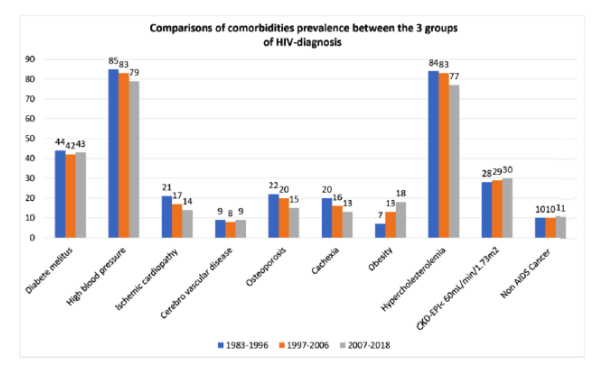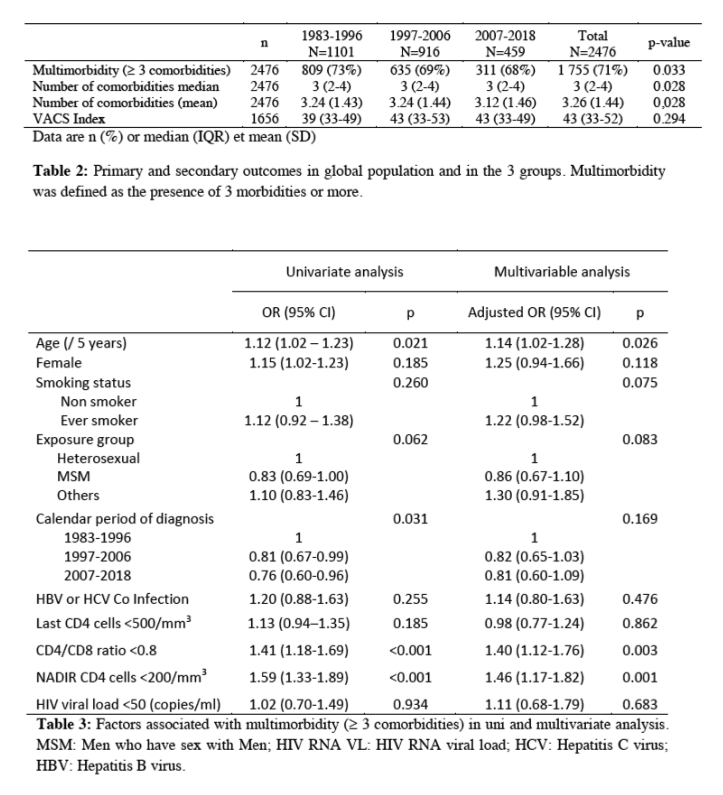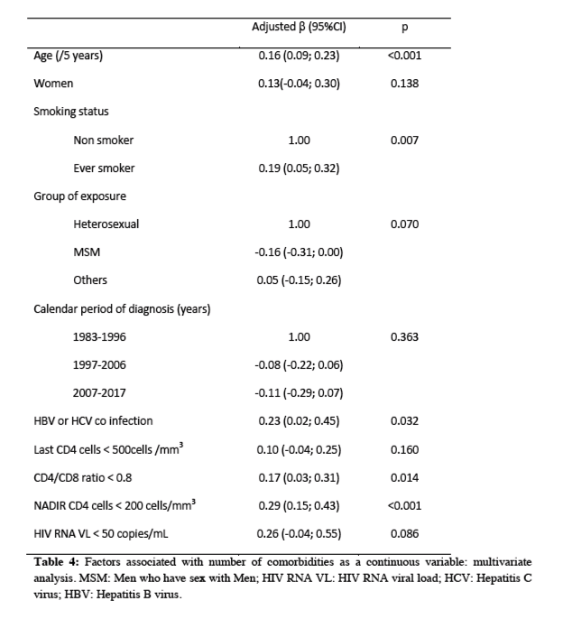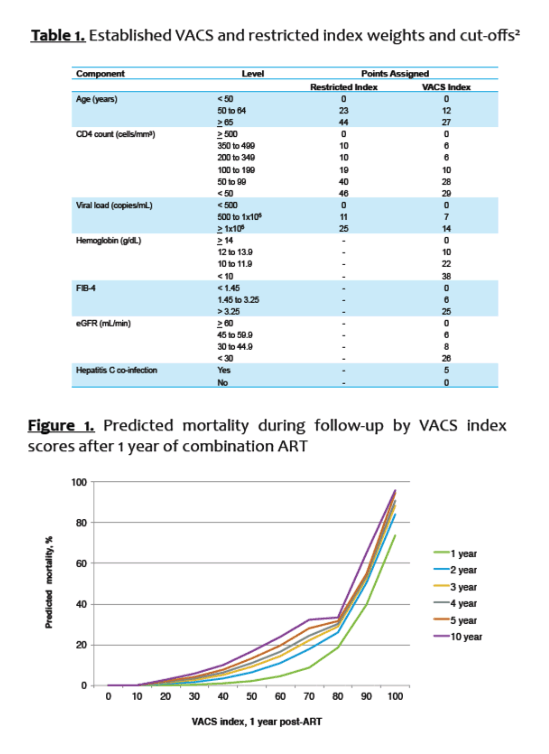| |
Multimorbidity in Elderly Subjects according to the year of diagnosis of HIV-Infection - A Cross-Sectional DATAIDS Cohort Study....'40% diabetes, 10% cancers, 80% elevated cholesterol, 30% low kidney function eGFR <60, 20% osteoporosis, 80% high blood pressure
|
| |
| |
Download the PDF here
Clinical Infectious Diseases 09 December 2019
Summary: We assessed multimorbidity (MM) according to the period of HIV diagnosis in 2476 people living with HIV over 70 years. MM was associated with older age, CD4/CD8 ratio and nadir CD4 cells, but not period of HIV diagnosis. ....Mean value of VACS score was 43 points in our study, with no difference between the 3 groups. VACS 2.0 Index is now said to be more accurate but below is old VACS just to show how it works, awarding points for each lab test & total VACS score so they say can predict mortality.
We evaluated whether MM was associated with periods of HIV-diagnosis, after adjusting for relevant covariates, in a geriatric population of PLHIV. Our results showed that the prevalence of MM was high and associated with age, low ratio CD4/CD8 and a nadir CD4 cells < 200/mm3 but not with the calendar period of HIV diagnosis.
MM [multimobidity] was defined as at least three co-existent morbidities of either high blood pressure (HBP), diabetes mellitus, osteoporosis, non-AIDS cancer, chronic renal failure, cardio and cerebrovascular disease, obesity, cachexia or hypercholesterolemia.....MM prevalence was 71%......MM was associated with older age, CD4/CD8 ratio < 0.8 and nadir CD4 cells < 200 cells/mL. Similar results were found with secondary and sensitivity analyses.

We analyzed 2476 subjects. Median age was 73 years, 75% were male, 51% heterosexuals, 36% men who had sex with men (MSM) and 8% were born in Sub-Saharan Africa. Less than 1% acquired HIV through intra-venous use (IDU). More than 94% were on cART. Thirty six percent were ever smokers Median duration of HIV infection and cART was respectively 20.2 and 17.9 years. Median CD4 cell count was 578 /mm3, 94% had undetectable viral load (<50 copies/mL) and median nadir CD4 level was 175/mm3.
In conclusion, despite caveats inherent to a cross-sectional design, our results have important clinical implications. First, they underscore the high rates of comorbidities and MM in elderly PLHIV, as well as the comorbidities at stake. Second, our study does not support periods of HIV-diagnosis or durations of known HIV-infection as an independent, clinically important factor associated with MM. Our finding may be a result of survival bias, but does not undermine the potential impact of HIV on MM, as other important HIV-associated factors such as nadir CD4 levels or CD4/CD8 ratio were associated with the outcome. As such, the duration of HIV-diagnosis seems not to be a criterion for selecting a geriatric population at risk of MM.
Abstract
Objective
We assessed prevalence of multimorbidity (MM) according to year of HIV diagnosis in people living with HIV (PLHIV) of geriatric age.
Design
Cross-sectional study of MM in PLHIV over 70 years old from the Dat'AIDS French multicentric cohort. MM was defined as at least three co-existent morbidities of either high blood pressure (HBP), diabetes mellitus, osteoporosis, non-AIDS cancer, chronic renal failure, cardio and cerebrovascular disease, obesity, cachexia or hypercholesterolemia. Logistic regression models evaluated the association between MM and calendar periods of HIV-diagnosis (1983-1996, 1997-2006 and 2007-2018). The secondary analysis evaluated MM as a continuous outcome and a sensitivity analysis excluded PLHIV with nadir TCD4 cells < 200 cells/mm3.
Results
Between January 2017 and September 2018, 2476 PLHIV were included. Median age was 73 years old, 75% were men, median CD4 was 578 cells/mL, and 94% had controlled viremia. MM prevalence was 71%.
HBP and hypercholesterolemia were the most prevalent comorbidities.
After adjustment for age, gender, smoking status, HCV, HBV co-infection, group of exposure, nadir CD4, and CD4:CD8 ratio and last CD4 levels, calendar periods of diagnosis was not associated with MM (p=0.169). MM was associated with older age, CD4/CD8 ratio < 0.8 and nadir CD4 cells < 200 cells/mL. Similar results were found with secondary and sensitivity analyses.
Conclusion
MM prevalence was high and increased with age, low CD4/CD8 ratio and nadir CD4 cells < 200mm3 but was not associated with calendar periods of HIV-diagnosis. Known duration of HIV-diagnosis does not seem a criterion for selecting elderly PLHIV at risk of MM.
Several controlled studies have revealed an increased prevalence of MM and comorbidities in PLHIV. In 2011, an Italian study assessed the prevalence of NCD and MM in a cohort of PLHIV compared to age-, sex- and race-matched controls 16: the prevalence of MM in PLHIV anticipated those observed in the controls by 10 years. A Dutch study 17 also found a higher prevalence of high blood pressure, myocardial infarction, peripheral artery disease, and impaired renal function in PLHIV. Another Italian study found an association between the prevalence of co-morbidities and the duration of HIV-disease 18. In order to assess the impact of MM, a specific index has been developed in PLHIV: the Veterans Ageing Cohort Study (VACS) Index (https://medicine.yale.edu/intmed/vacs/welcome/vacsindexinfo.aspx). This index predicted hospitalizations and all-cause mortality 19,20, and was associated with frailty 21.
Additional studies on MM prevalence in the geriatric PLHIV are needed. Elderly PLHIV are probably very heterogeneous in terms of duration of HIV-disease, with people acquiring the virus at an advanced age, and therefore only recently exposed to HIV and cART, and people contracting the infection at earlier ages, with longer expositions. In this study, we sought to evaluate the association between MM and calendar periods of HIV-diagnosis in an HIV-infected population aged 70 years or more, and test the hypothesis that PLHIV with a longer history of known HIV-diagnosis are associated with increased risk of MM after adjusting for confounders.



|
|
| |
| |
|
|
|